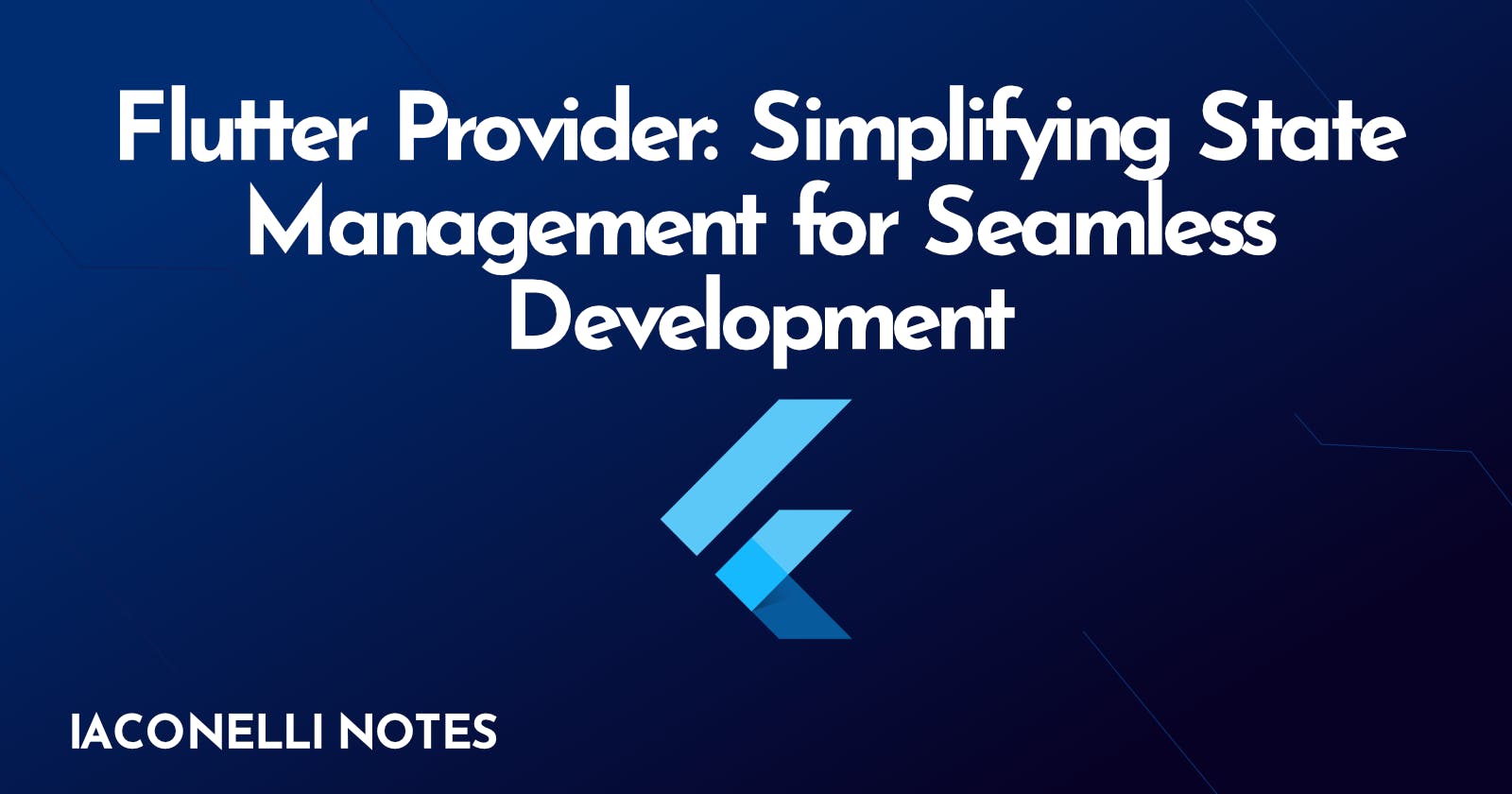Flutter Provider: Simplifying State Management for Seamless Development
6 min read

Introduction
In the realm of Flutter app development, efficient state management is the key to building robust and maintainable applications. One popular solution that has gained immense popularity among developers is Flutter Provider. Offering a simple and intuitive way to manage and share application state, Provider has revolutionized how Flutter developers approach state management. In this blog post, we will delve into the intricacies of Flutter Provider and explore how it empowers developers to create delightful user experiences while maintaining a clean and scalable codebase.
Understanding the Basics of Flutter Provider
To embark on our journey, let's start by understanding the basic concepts of Flutter Provider. At its core, Provider is a lightweight and flexible state management solution that follows the InheritedWidget pattern. It enables the effortless propagation of state changes throughout the widget tree, ensuring that widgets are updated efficiently whenever the underlying data changes. Provider eliminates the need for excessive boilerplate code, allowing developers to focus on building amazing user interfaces and implementing critical business logic.
Simplicity and Conciseness
One of the remarkable aspects of Flutter Provider is its simplicity. With just a few lines of code, developers can establish a robust state management system. Provider leverages the power of Dart's built-in features such as InheritedWidget, BuildContext, and Consumer to effortlessly expose and consume state across the widget tree. This simplicity not only makes code more readable and maintainable but also expedites the development process. By minimizing the cognitive load associated with state management, Flutter Provider empowers developers to focus on the creative aspects of app development.
import 'package:flutter/material.dart';
import 'package:provider/provider.dart';
class Counter with ChangeNotifier {
int _count = 0;
int get count => _count;
void increment() {
_count++;
notifyListeners();
}
}
// ... Rest of the code ...
Dependency Injection and Scoped Instances
Provider goes beyond basic state management by providing dependency injection capabilities. This feature allows developers to inject dependencies into widgets, enabling decoupling and testability. Provider offers a range of providers, including Provider, ChangeNotifierProvider, and FutureProvider, to cater to various scenarios. These providers not only manage the state but also automatically dispose of resources when they are no longer needed, reducing memory leaks and enhancing performance.
import 'package:flutter/material.dart';
import 'package:provider/provider.dart';
class DataService {
// ... Data service implementation ...
}
class HomePage extends StatelessWidget {
@override
Widget build(BuildContext context) {
final dataService = Provider.of<DataService>(context);
// Use dataService to retrieve data and build UI
// ...
}
}
void main() {
runApp(
MultiProvider(
providers: [
ChangeNotifierProvider<DataService>(
create: (context) => DataService(),
),
// More providers can be added here
],
child: MyApp(),
),
);
}
class MyApp extends StatelessWidget {
@override
Widget build(BuildContext context) {
return MaterialApp(
title: 'Flutter Provider Demo',
theme: ThemeData(primarySwatch: Colors.blue),
home: HomePage(),
);
}
}
In this example, we introduce a DataService class, which represents a dependency that we want to inject into widgets. We define the DataService class separately and then provide it using ChangeNotifierProvider in the main function.
The HomePage widget demonstrates how to consume the DataService using Provider.of<DataService>(context). This approach allows HomePage and its descendants to access and utilize the shared instance of DataService throughout the widget tree. By injecting dependencies using providers, we achieve loose coupling between widgets and promote testability and reusability.
The MultiProvider widget is used to wrap multiple providers together, allowing for the injection of multiple dependencies in a single application. Additional providers can be added inside the providers list to accommodate different dependencies.
Reactive and Granular State Updates
Flutter Provider shines when it comes to reactive programming and granular state updates. By combining Provider with ChangeNotifier, developers can achieve fine-grained control over their app's state. When the state changes, only the affected widgets are rebuilt, leading to efficient rendering and improved performance. This level of granularity ensures that your Flutter app remains responsive and provides a seamless user experience even with complex state management requirements.
import 'package:flutter/material.dart';
import 'package:provider/provider.dart';
class Counter with ChangeNotifier {
int _count = 0;
int get count => _count;
void increment() {
_count++;
notifyListeners();
}
}
class CounterDisplay extends StatelessWidget {
@override
Widget build(BuildContext context) {
return Consumer<Counter>(
builder: (context, counter, _) => Text(
counter.count.toString(),
style: TextStyle(fontSize: 40),
),
);
}
}
class CounterButton extends StatelessWidget {
@override
Widget build(BuildContext context) {
return ElevatedButton(
onPressed: () {
Provider.of<Counter>(context, listen: false).increment();
},
child: Text('Increment'),
);
}
}
void main() {
runApp(
ChangeNotifierProvider(
create: (context) => Counter(),
child: MyApp(),
),
);
}
class MyApp extends StatelessWidget {
@override
Widget build(BuildContext context) {
return MaterialApp(
title: 'Flutter Provider Demo',
theme: ThemeData(primarySwatch: Colors.blue),
home: Scaffold(
appBar: AppBar(
title: Text('Counter App'),
),
body: Center(
child: Column(
mainAxisAlignment: MainAxisAlignment.center,
children: [
Text(
'Counter Value:',
style: TextStyle(fontSize: 20),
),
CounterDisplay(),
SizedBox(height: 20),
CounterButton(),
],
),
),
),
);
}
}
In this example, we have a Counter class that extends ChangeNotifier from the provider package. The Counter class has a private _count variable representing the state we want to manage. We provide a get method to access the count value and an increment method to update the count. When the count changes, we call notifyListeners() to notify the listeners (in this case, the CounterDisplay widget) about the state change.
The CounterDisplay widget uses Consumer<Counter> to subscribe to the changes in the Counter state. It rebuilds only the associated part of the UI (the displayed count) when the state changes.
The CounterButton widget uses the onPressed callback to increment the count by accessing the Counter instance with Provider.of<Counter>(context, listen: false). It does not listen for state changes because it only triggers an action.
In the main function, we wrap the ChangeNotifierProvider around our app, specifying the Counter as the value to be provided. This makes the Counter instance available to all the widgets beneath it in the widget tree.
The MyApp widget represents the root widget of the app. It sets up the MaterialApp and defines the UI layout using the Scaffold, AppBar, and the CounterDisplay and CounterButton widgets.
Integration with DevTools and Testing
Flutter Provider seamlessly integrates with the Flutter DevTools suite, providing powerful debugging and profiling capabilities. With DevTools, developers can inspect the state changes, track performance bottlenecks, and gain valuable insights into their app's behavior. Additionally, Provider's inherent simplicity and testability make it an ideal candidate for unit and widget testing. By leveraging the testing framework, developers can write comprehensive tests to ensure the correctness of their state management code.
Conclusion
In conclusion, Flutter Provider offers a delightful state management solution that simplifies the development process while ensuring a scalable and maintainable codebase. Its simplicity, dependency injection capabilities, reactive programming model, and integration with DevTools make it a go-to choice for Flutter developers. By leveraging Provider, developers can focus on building engaging user interfaces and crafting memorable app experiences. So, if you're looking for a robust and elegant state management solution for your next Flutter project, give Flutter Provider a try and witness the magic of efficient state management unfold before your eyes
